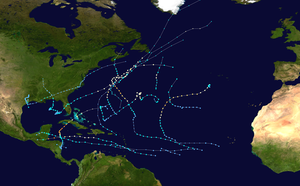Tropical Depression Nine (2001)
Tropical Depression Nine caused minor flooding in Central America in September 2001. The ninth tropical cyclone of the 2001 Atlantic hurricane season, the depression developed from a tropical wave in the southwestern Caribbean Sea on September 19. Without significant intensification, the depression made landfall in Puerto Cabezas, Nicaragua early on September 20, which was about six hours after becoming a tropical cyclone. Once inland over Central America, the depression significant deteriorated and dissipated later that day, after lasting for less than 24 hours. The remnants emerged into the Pacific Ocean and later developed into Hurricane Juliette. Impact from the depression was rather minor. Although sustained winds on land did not exceed 30 mph (55 km/h), a fallen tree injured three children in El Salvador. In addition, heavy rainfall flooded at least 200 homes in San Salvador and inundated 15 farms. The depression did not result in fatalities and damage caused by it is unknown.
| Tropical depression (SSHWS/NWS) | |
 Tropical Depression Nine shortly before formation on September 19 | |
| Formed | September 19, 2001 |
|---|---|
| Dissipated | September 20, 2001 |
| Highest winds | 1-minute sustained: 35 mph (55 km/h) |
| Lowest pressure | 1005 mbar (hPa); 29.68 inHg |
| Fatalities | None reported |
| Areas affected | Nicaragua, El Salvador |
| Part of the 2001 Atlantic hurricane season | |
Meteorological history

A tropical wave exited the west coast of Africa and emerged into the Atlantic Ocean on September 11.[1] After tracking westward for five days, the wave entered the Caribbean Sea on September 16. Convection steadily increased in both coverage and intensity, and by September 19, the system reached the southwestern Caribbean Sea.[1] Satellite imagery and surface observations indicated that Tropical Depression Nine formed at 1800 UTC on September 19, while located 50 miles (80 km) north-northwest of San Andres Island.[1]
Initially, the depression had two centers of circulation, one east of Costa Rica and one east of Puerto Cabezas, Nicaragua. Because the thunderstorm activity was more intense and persistent at the northern circulation, advisories were initiated using the latter.[2] Computer forecast models predicted that the depression would make landfall in Nicaragua[2] and then enter the eastern Pacific Ocean within 36 hours. Other computer forecast models separated it into two systems, with the northern center going into the Bay of Campeche and the southern center going westward through Costa Rica and into the Pacific while strengthening into a "significant tropical cyclone". Although only a tropical depression, upper level outflow was circular and was indicative of a more "mature" tropical cyclone.[2]
At 0000 UTC on September 20, the depression made landfall near Punta Cabezas, Nicaragua with winds of 35 mph (55 km/h) and weakening was immediately forecast.[1][3] Three hours later, the National Hurricane Center issued its final advisory, as the lower level center became poorly defined because of interaction with the mountains of Central America and deep thunderstorm activity had significantly diminished.[4] The National Hurricane Center noted the possibility of regeneration, if the circulation entered into the Pacific Ocean within a few days.[4] Although the depression never redeveloped, the remnant tropical wave emerged into the Pacific Ocean and contributed to the development of Hurricane Juliette on September 21.[1][5]
Preparations and Impact
Upon development of the tropical depression, a tropical storm watch was issued from Bluefields, Nicaragua to Dangriga, Belize. When the depression made landfall, this warning was discontinued.[2][4] Residents in El Salvador were advised to avoid rivers due to possible flooding but no mandatory evacuations were put in place. A green alert was issued in Nicaragua due to the threat of heavy rains and high winds. This alert remained in effect until September 21. Three children were injured by a fallen tree in the country.[6] The highest sustained winds on land from the depression were reported at Punta Cabezas, Nicaragua with winds of 30 mph (50 km/h) and a minimum pressure of 1,006 mbar (29.7 inHg).[1] A total of 1.8 inches (46 mm) of rain was recorded in Bluefields while up to 5.9 inches (150 mm) was estimated to have fallen in mountainous areas.[7]
In El Salvador, heavy rains from the depression helped alleviate drought conditions; however, flooding also inundated 200 homes in San Salvador along the Acelhuate River.[8] Fifteen farms were inundated by flooding, five of which were destroyed. Seventy people evacuated to shelters set up after the storm by the local Red Cross and armed forces. Military crews were quickly deployed to help clean up the damages on September 22.[9] Although it passed over Central America, there are no reports of damage or deaths in the region due to the tropical depression.[1]
References
- Beven, Jack L. (October 24, 2001). "Tropical Cyclone Report: Tropical Depression Nine" (PDF). National Hurricane Center. Retrieved May 24, 2012.
- Stewart, Stacy R. (September 19, 2001). "Tropical Depression Nine Discussion Number 1". National Hurricane Center. Retrieved May 24, 2012.
- Avila, Lixion A. (September 19, 2001). "Tropical Depression Nine Intermediate Advisory 1A". National Hurricane Center. Retrieved May 24, 2012.
- Avila, Lixion A. (September 19, 2001). "Tropical Depression Nine Discussion Number 2 (Final)". National Hurricane Center. Retrieved May 24, 2012.
- Lawrence, Miles B.; Mainelli, Michelle M. (October 30, 2001). "Hurricane Juliette Tropical Cyclone Report". National Hurricane Center. Retrieved May 24, 2012.
- Laura, Rafael (September 21, 2001). "Tormenta se aleja de Nicaragua" (in Spanish). El Nuevo Diario. Archived from the original on February 25, 2012. Retrieved May 24, 2012.
- Morales, Amalia (September 20, 2001). "Alerta verde por lluvias" (in Spanish). La Prensa. Retrieved May 24, 2012.
- "Climate of 2001 - September". National Climatic Data Center. October 17, 2001. Archived from the original on February 24, 2012. Retrieved May 24, 2012.
- Torres, Carlos; Zambrano, Roberto (September 22, 2001). "Inundaciones y derrumbes por clima lluvioso" (in Spanish). El Diario de Hoy. Archived from the original on 2012-09-20. Retrieved May 24, 2012.
